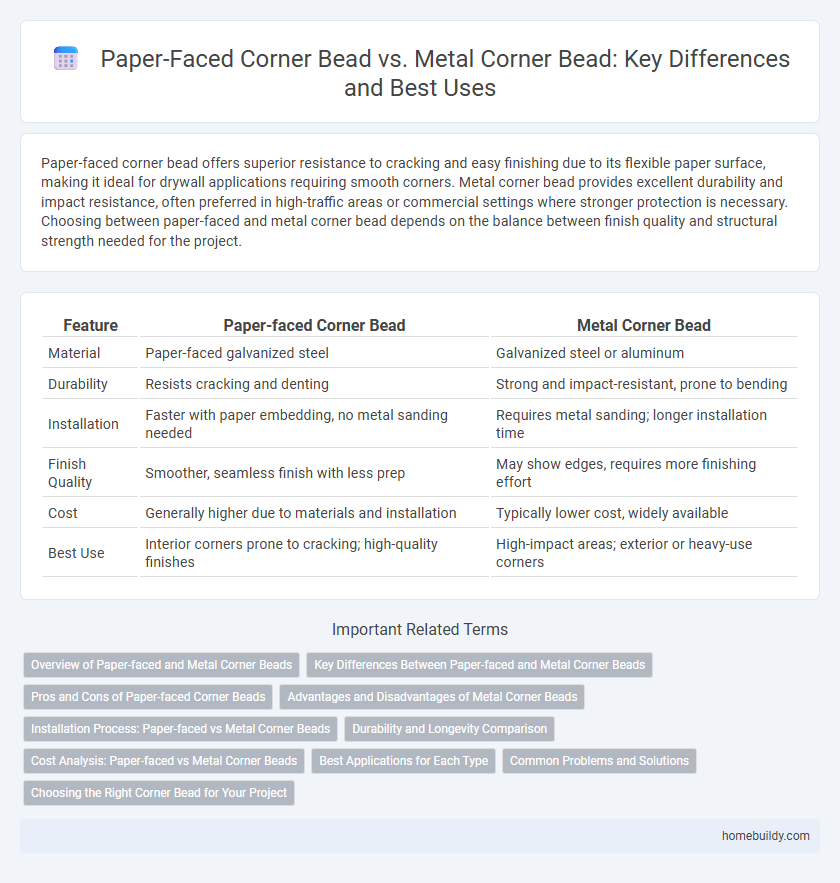Paper-faced corner bead offers superior resistance to cracking and easy finishing due to its flexible paper surface, making it ideal for drywall applications requiring smooth corners. Metal corner bead provides excellent durability and impact resistance, often preferred in high-traffic areas or commercial settings where stronger protection is necessary. Choosing between paper-faced and metal corner bead depends on the balance between finish quality and structural strength needed for the project.
Table of Comparison
| Feature | Paper-faced Corner Bead | Metal Corner Bead |
|---|---|---|
| Material | Paper-faced galvanized steel | Galvanized steel or aluminum |
| Durability | Resists cracking and denting | Strong and impact-resistant, prone to bending |
| Installation | Faster with paper embedding, no metal sanding needed | Requires metal sanding; longer installation time |
| Finish Quality | Smoother, seamless finish with less prep | May show edges, requires more finishing effort |
| Cost | Generally higher due to materials and installation | Typically lower cost, widely available |
| Best Use | Interior corners prone to cracking; high-quality finishes | High-impact areas; exterior or heavy-use corners |
Overview of Paper-faced and Metal Corner Beads
Paper-faced corner beads consist of a metal or plastic core covered with paper, offering superior adhesion and a smooth finish for drywall corners, ideal for achieving crack-resistant edges. Metal corner beads, typically made from galvanized steel or aluminum, provide robust durability and impact resistance, making them suitable for high-traffic areas prone to damage. Both types are essential in drywall finishing, with paper-faced options favored for seamless paint-ready surfaces and metal beads preferred for their strength and long-lasting protection.
Key Differences Between Paper-faced and Metal Corner Beads
Paper-faced corner beads offer superior flexibility and are ideal for drywall applications requiring smooth finishing and easy paint adhesion, while metal corner beads provide greater durability and impact resistance suitable for high-traffic areas. Paper-faced variants reduce cracking and allow for seamless installation with joint compound, whereas metal beads resist denting and wear but may require sanding to smooth edges. The choice depends on the balance between aesthetic finish and structural robustness needed in the specific construction environment.
Pros and Cons of Paper-faced Corner Beads
Paper-faced corner beads offer superior flexibility and ease of installation, making them ideal for drywall corners requiring smooth finishes and reduced cracking risk. Their lightweight and rust-resistant properties enhance durability compared to metal corner beads, which can corrode over time and be harder to handle. However, paper-faced corner beads may be less impact-resistant and less suitable for high-traffic areas where metal corner beads provide stronger protection.
Advantages and Disadvantages of Metal Corner Beads
Metal corner beads offer exceptional durability and impact resistance, making them ideal for high-traffic areas and long-lasting protection against dents and wear. However, they are prone to rust if not properly coated or maintained, which can compromise the integrity of the drywall corner over time. Installation requires precise fastening to prevent bending or warping, potentially increasing labor time compared to flexible paper-faced corner beads.
Installation Process: Paper-faced vs Metal Corner Beads
Paper-faced corner beads offer easier installation due to their lightweight, flexible design that allows quick alignment and seamless embedding in joint compound. Metal corner beads require precise cutting, nailing, or screwing to securely fasten, demanding more time and tools for a sturdy setup. The paper-faced option reduces sanding and finishing effort, improving overall efficiency compared to the more labor-intensive metal corner bead installation.
Durability and Longevity Comparison
Paper-faced corner bead offers excellent flexibility and resistance to cracking, making it ideal for interior applications with moderate impact. Metal corner bead, typically made from galvanized steel or aluminum, provides superior durability and impact resistance, ensuring long-lasting protection in high-traffic or exterior environments. While paper-faced varieties resist mold and rust, metal corner beads withstand harsher conditions and physical damage, resulting in greater longevity over time.
Cost Analysis: Paper-faced vs Metal Corner Beads
Paper-faced corner beads typically cost more upfront than metal corner beads due to their composite materials and added durability. Metal corner beads, usually made from galvanized steel or aluminum, offer a lower initial purchase price but may incur higher long-term costs from potential rusting or denting repairs. Factoring in installation complexity and maintenance needs, paper-faced beads often provide better overall value despite the higher initial investment.
Best Applications for Each Type
Paper-faced corner bead offers superior flexibility and moisture resistance, making it ideal for interior walls in high-humidity areas such as bathrooms and kitchens. Metal corner bead provides exceptional durability and impact resistance, best suited for high-traffic commercial spaces or exterior corners exposed to harsh conditions. Selecting paper-faced corner bead enhances finish smoothness on curved surfaces, while metal corner bead ensures long-lasting protection against dents and abrasions.
Common Problems and Solutions
Paper-faced corner beads often face issues like water damage and peeling paint due to their composite materials, which can be mitigated by ensuring proper drywall compound application and maintaining ventilation. Metal corner beads commonly encounter denting and rusting, especially in high-traffic areas, but using galvanized steel or aluminum options along with regular inspections prevents corrosion and maintains durability. Choosing the right corner bead type based on environment and applying appropriate finishing techniques addresses common problems effectively.
Choosing the Right Corner Bead for Your Project
Paper-faced corner bead offers superior resistance to cracking and provides a smooth, paint-ready surface, ideal for interior drywall applications where durability and finish quality are priorities. Metal corner bead is more durable against physical impacts and is commonly chosen for high-traffic areas or exterior corners that require extra protection. Selecting the right corner bead depends on the project's specific needs for flexibility, moisture resistance, and durability to ensure a long-lasting, professional finish.
Paper-faced corner bead vs Metal corner bead Infographic

 homebuildy.com
homebuildy.com